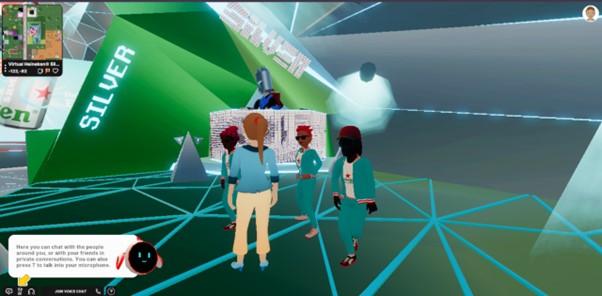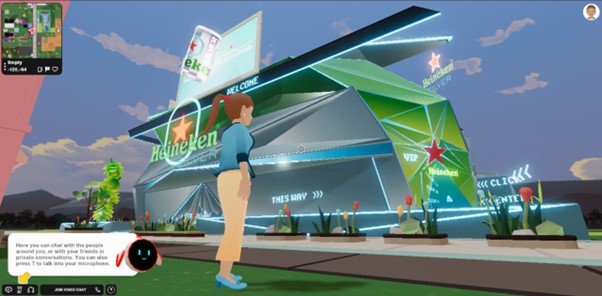The metaverse, a network of virtual 3D spaces that connects people globally via immersive VR technology, has become a hot topic in recent years. After Facebook’s rebranding to ‘Meta’ and announcement of its investments in making the metaverse a reality, many companies jumped on the bandwagon, expressing their intentions to explore this novel virtual platform. Among them was Heineken, the Dutch beer brewing giant, which seized this opportunity to promote its newest innovative drink; Heineken Silver. Can a virtual Heineken be enjoyed as much as one in the real world?
Heineken’s big launch took place in June 2022, in partnership with the metaverse platform Decentraland. They built a virtual brewery and invited metaverse users, live streamers, and colleagues to join in on the celebration. The event featured a DJ, a virtual buffet, and, of course, a virtual bar. The launch of their beer was filled with tongue-in-cheek comments and slogans, asking attendees to “taste” the virtual beer and share their thoughts (Heineken N.V., 2022).
Heineken never intended to successfully launch a virtual product line. Instead, their marketing team aimed to generate brand awareness for their newest innovation, by using the trending concepts of virtual assets and the metaverse. The campaign was ultimately designed to persuade metaverse users to go out and enjoy the real world with a real beer (De Seta, 2022).
Despite Heineken not being entirely convinced that virtual consumables are the future, there remains a market for digital consumption. Decentraland’s online store, to this day, sells digital clothing, furniture, and much more (Decentraland, 2024). Further proving that the metaverse and digital assets are still relevant topics is the recent acquisition of London-based company LandVault, which specializes in building and delivering digital twins and immersive experiences in the metaverse (Symcox, 2024). The firm Infinite Reality acquired it for an extraordinary £350 million (Ibid). This acquisition underscores the ongoing interest and investment in the metaverse.
Heineken boasts their vision of “brewing the joy of true togetherness.” Although those who attended the launch of the virtual Heineken were still left quite thirsty in reality afterward, the entire stunt did bring people together to share in virtually brewed togetherness via a digital medium.
In my opinion, the importance of physical versus digital assets diminishes if our true goal is to be together and create memories. Whether a beer is virtual or a fresh, cold one doesn’t really matter—as long as you’re not thirsty and looking to quench it with something.

References
De Seta, D. 2022 The virtual Heineken Silver case study, https://www.youtube.com/watch?v=yVud38Ea6GY
Decentraland, 2024, Welcome to Decentraland Available at: https://decentraland.org/.
Heineken N.V., 2022, https://www.heineken.com/nl/nl/decentraland Available at: https://www.heineken.com/nl/nl/decentraland.
Symcox, J., 2024 £350m swoop for London metaverse firm Landvault. BusinessCloud. Available at: https://businesscloud.co.uk/news/350m-swoop-for-london-metaverse-firm-landvault/.


